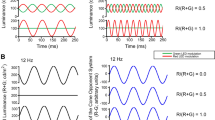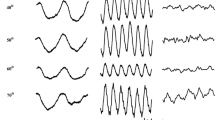Summary
Frequency response curves of the human ERG to monochromatic light at different luminances demonstrate a Purkinje shift in the frequency domain. The rod ERG system resembles a low pass filter, whereas the cones have attributes of a higher band pass filter. The ERG appears linear at small amplitudes. The conspicuous non-linearities are saturation of the rods at high light levels and a double harmonic of the cones.
Résumé
La réponse de fréquence de l'ERG humain à la lumière monochromatique avec des luminances variées montre le phénomène Purkinje dans le domain de fréquence. Le système des bâtonnets dans l'ERG ressemble un filtre laissant passer les basses fréquences. Les cônes ont la propriété d'un filtre de bande pour les fréquences plus augmentées. L'ERG semble d'être linéair pour les amplitudes assez minces. Les non-linéarités les plus evidentes sont la saturation des bâtonnets aux niveaux élevés de lumière et une seconde harmonique des cones.
Zusammenfassung
Die Frequenz-Kurven des menschlichen ERG mit monochromatischem Lichte verschiedener Helligkeiten zeigen eine Purkinje Verschiebung im Frequenz-Bereich. Das Stäbchen-ERG ist zu vergleichen mit einem Filter, der niedrige Frequenzen ungeschwächt durchlässt. Die Zapfen gleichen mehr einem Bandfilter mit höheren Frequenzen. Das ERG hat bei niedrigen Amplituden linearen Charakter. Die bemerkenswertesten Nicht-Linearitäten sind die Sättigung der Stäbchen bei höherer Leuchtdichte und zweite Obertöne bei den Zapfen.
Similar content being viewed by others
References
Aguilar, M. & Stiles, W. S. (1954) Saturation of the Rod Mechanism of the Retina at High Levels of Stimulation; Opt. Acta 1, 59–65.
Armington J. C. & Biersdorf, W. R. (1956) Flicker and Color Adaptation in the Human Electroretinogram; J. opt. Soc. Amer. 46, 393–400.
—, & Schwab, G. J. (1954) Electroretinogram in Nyctalopia; Arch. Ophthal. 52, 725–733.
Bornschein, H. (1964) Physiologische Aspekte des Flimmer-Elektroretinogramms: Komponenten und Frequenzcharakteristik. Docum. Ophthal. 18, 85–100.
Brindley, G. W. (1960) Physiology of the Retina and the Visual Pathway. Williams and Wilkins Company, Baltimore.
Cavonius, C. R. (1964) Color Sensitive Responses in the Human Flicker-ERG. Docum. Ophthal. 18, 101–113.
deLange, H. (1954) Relationship Between Critical Flicker-Frequency and a Set of Low-Frequency Characteristics of the Eye; J. opt. Soc. Amer. 44, 380–389.
—, (1958a) Research into the Dynamic Nature of the Human Fovea-Cortex Systems with Intermittent and Modulated Light. I. Attenuation Characteristics with White and Colored Light; J. opt. Soc. Amer. 48, 777–784.
—, (1958b) Research into the Dynamic Nature of the Human Fovea-Cortex Systems with Intermittent and Modulated Light. II. Phase Shift in Brightness and Delay in Color Perception; J. opt. Soc. Amer. 48, 784–789.
DeVoe, R. D. (1961) Electrical Responses to Flicker in the Eye of the Wolf Spider, Lycosa baltimoriana; Thesis, April 1961, The Rockefeller Institute, New York.
—, (1962) Linear Superposition of Retinal Action Potentials to Predict Electrical Flicker Responses from the Eye of the Wolf Spider, Lycosa baltimoriana (Keyserling); J. gen. Physiol. 46, 75–96.
Franceschetti, A., Dieterle, P. & Gernet, H. (1958) L'importance de l'électrorétinogramme scoptopique pour la classification clinique des différentes formes d'héméralopie d'origine génotypique. Acta XVII Conc. Ophthal. 1: 589–599; Bruxelles: Imprimérie Médicale et Scientifique, S.A. 1959.
Gouras, P. & Gunkel, R. D. (1962) The Resonant Frequencies of Rod and Cone Electroretinograms; Invest. Ophthal. 1, 122–126.
Granit, R. (1955) Receptors and Sensory Perception. Yale University Press, New Haven.
Ives, H. G. (1922) Critical Frequency Relations in Scotopic Vision; J. opt. Soc. Amer. 6: 254.
Kelly, D. H. (1959) Effects of Sharp Edges in a Flickering Field; J. opt. Soc. Amer. 49, 730–732.
—, (1961) Visual Responses to Time-Dependent Stimuli. I. Amplitude Sensitivity Measurements; J. opt. Soc. Amer. 51, 422–429.
Kirschfeld, K. (1961) Quantitative Beziehungen zwischen Lichtreiz und monophasischem Electroretinogramm bei Rüsselkäfern; Z. vergl. Physiol. 44, 371–413.
Levinson, J. (1964) Nonlinear and Spatial Effects in the Perception of Flicker Docum. Ophthal 18, 36–55.
Van derTweel, L. H. (1961) Some Problems in Vision Regarded with Respect to Linearity and Frequency Response; Ann. New York Acad. Sci. 89, 829–856.
Walls, G. L. & Heath, G. G. (1954) Typical Total Blindness Reinterpreted; Acta ophthal. Kbh. 32, 253–297.
Author information
Authors and Affiliations
Additional information
From the Ophthalmology Branch, National Institute of Neurological Diseases and Blindness, National Institutes of Health, U.S. Public Health Service, Department of Health Education and Welfare, Bethesda.
Rights and permissions
About this article
Cite this article
Gouras, P., Gunkel, R.D. The frequency response of normal, rod achromat and nyctalope ERGs to sinusoidal monochromatic light stimulation. Doc Ophthalmol 18, 137–150 (1964). https://doi.org/10.1007/BF00160570
Issue Date:
DOI: https://doi.org/10.1007/BF00160570




